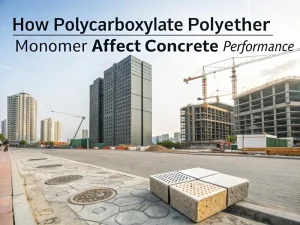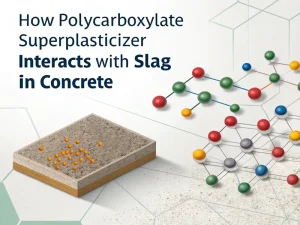Blog

Self-compacting concrete (SCC) has revolutionized the construction industry due to its ability to flow and fill formwork without mechanical vibration. This innovation makes buildings faster, more efficient, and less labor-intensive. A key factor in achieving SCC’s unique performance is using concrete admixtures.
This article will explore everything you need to know about self-compacting concrete admixtures, including their types, functions, and how they create durable, high-quality structures.
Self-compacting concrete is a high-performance concrete that can flow, compact, and evenly spread under gravity. Even with dense steel bars, it can completely fill the formwork without segregation or bleeding. At the same time, it achieves good homogeneity and does not require additional vibration.
SCC is mainly used for projects with dense steel bars or complex geometric shapes that make traditional concrete pouring difficult.
Admixtures are chemicals or minerals added to concrete during mixing to alter its properties. Admixture for self-compacting concrete it play a crucial role in ensuring their fluidity, stability, and resistance to segregation. These admixture help achieve the desired performance characteristics while maintaining the integrity and durability of the concrete.
Self-compacting concrete requires a delicate balance between fluidity and stability. Without additives, achieving this balance is almost impossible.
Enhancement and workability: Ensure that concrete flows freely without mechanical vibration.
Prevent segregation: Maintain uniformity and prevent separation of coarse aggregates.
Improve durability: Reduce moisture content while maintaining strength and cohesion.
Improve efficiency: SCC can be poured faster, improving on-site efficiency
Better surface quality: A smooth and defect-free surface can be achieved with minimal effort.
Superplasticizers are crucial in self-compacting concrete, as they can improve their flowability by reducing their moisture content without affecting their processability. They enhance the fluidity of the mixture, allowing it to flow into narrow spaces and around dense steel bars.
Superplasticizers improve self-compacting concrete’s workability, strength, and flowability by dispersing cement particles, reducing water usage, and lowering the water-cement ratio.
Polycarboxylate ether (PCE) has excellent slump retention and compatibility with other additives.
Sulfonated melamine formaldehyde (SMF) can quickly reduce moisture, but the slump retention time may be shorter.
VMA is crucial for maintaining the cohesiveness of SCC and preventing aggregate separation. It retains its stability by controlling the viscosity of SCC.
Hydroxypropyl methylcellulose (HPMC) effectively controls moderate viscosity.
Xanthan gum: Provides high viscosity, but excessive use may reduce fluidity.
Air entraining admixture introduce microbubbles into concrete, improving its freeze-thaw cycle resistance, enhancing durability, alleviating internal pressure caused by water expansion in cold climates, and reducing the risk of cracking in freeze-thaw environments.
It allows self-compacting concrete to be constructed in cold environments.
Attention: Excessive air content will reduce intensity, the optimal dosage is usually 3-6%.
Adding fibers to SCC can enhance the toughness of self-compacting concrete to prevent cracking.
Polypropylene (PP) fibers are used to control plastic shrinkage.
Steel fibers are used for structural reinforcement. This is more applicable to parking lot floors.
Rheological modifiers regulate the flow characteristics of SCC, maintaining a balance between the flowability and viscosity of self-compacting concrete, ensuring stable flow and no separation phenomenon.
By selecting appropriate additives and optimizing their interactions, engineers can fully unleash the potential of SCC to achieve safer, faster, and more sustainable construction. Whether in skyscrapers, bridges, or prefabricated components, understanding the role of admixtures will help you create concrete solutions that meet project needs.

How Polycarboxylate Polyether Monomer Affect Concrete Performance
Blog How Polycarboxylate

How Polycarboxylate Superplasticizer Interacts With Slag In Concrete
Blog How Polycarboxylate